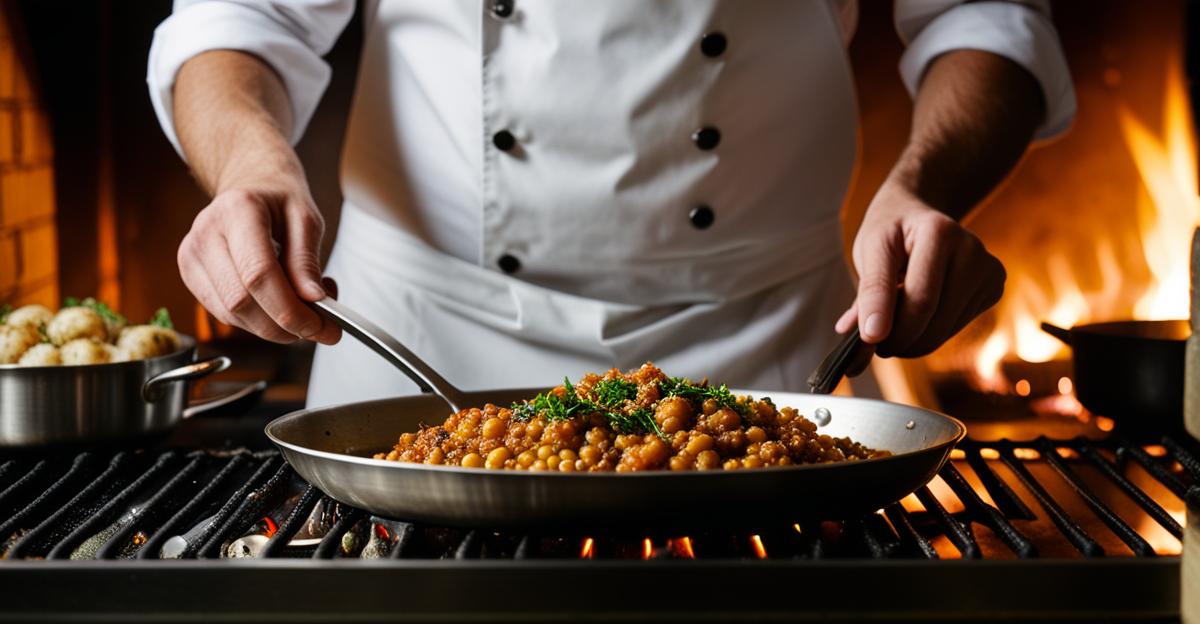Overview of Traditional UK Cooking
Traditional UK cooking is a tapestry woven from its historical context and geographical influences. The evolution of British cuisine is deeply rooted in its rich history, where early cooking practices were shaped by available local produce and preservation needs. For instance, the age-old art of curing meats and baking breads not only showcases the culinary practices but embodies the resourcefulness necessitated by the British climate.
The geography and climate of the UK have had a profound impact on its traditional dishes. The British Isles, surrounded by the North Atlantic Ocean and
Also to discover : What are the key techniques for cooking a succulent roast beef?
influenced by a diverse climate, have developed a cuisine reliant on hearty, warming meals. This is evident in staple dishes such as pies and puddings, designed to nourish and pacify during colder months.
Unique culinary techniques emerged from this context, such as the development of stewing and pudding-making. These methods, albeit humble, highlight a blend of practicality with a deep-seated culinary art which has been nurtured over the centuries. The traditional British penchant for boiling and roasting, paralleled with techniques like spicing and the use of herbs, underscores the subtle, yet significant, diversity within British fare.
In the same genre : How can you craft a hearty bubble and squeak dish?
Key Dishes Originating from the UK
Delving into the heart of British cuisine, several iconic dishes stand out not only for their flavour but also for their rich narratives and cultural roots. These culinary heritage jewels offer a window into the UK’s long-standing traditions and their global journey. Here, we explore three cornerstone dishes: Fish and Chips, Roast Beef with Yorkshire Pudding, and Shepherd’s Pie, each revered for its unique essence and history.
Fish and Chips
A quintessential part of British cuisine, Fish and Chips embodies simplicity and satisfaction. Originating in the 19th century, this dish quickly became a staple due to its accessibility and affordability. Crisp, battered fish accompanied by golden chips represents an era of industrial expansion and urbanisation. Its global journey saw it become a sought-after delicacy, especially in coastal regions worldwide, adapting subtly to fit local tastes.
Roast Beef and Yorkshire Pudding
Roast Beef and Yorkshire Pudding is a tradition-rooted Sunday meal, emblematic of British culinary pride. The grandeur of roast beef has long symbolized feast and celebration, often associated with family gatherings. Introduced in the 1700s, Yorkshire pudding was initially a clever way to make meals more filling. The dish encapsulates the resourcefulness of British cooking and has inspired variations globally, including American pot roasts and French beef dishes.
Shepherd’s Pie
A hearty dish with deep ties to pastoral life, Shepherd’s Pie reflects the land’s resources—spring lamb and potatoes. As a product of the sheep-rearing regions of Scotland and northern England, it marries simple ingredients with rustic technique. Over time, Shepherd’s Pie has traversed borders, evolving into cottage pie when made with beef and embracing global spices, providing comfort in various culinary cultures.
Traditional Ingredients and Their Global Impact
Traditional UK cooking has a storied history shaped by its geography and climate, which has given rise to an array of distinctive culinary ingredients. Common staples like potatoes, wheat, and dairy products have long been fundamental to British meals, each serving diverse roles in the diet. Potatoes, for instance, are not only the backbone of dishes such as Fish and Chips but are also featured prominently in casseroles and pies, showcasing their versatility.
The migration and adaptation of UK ingredients across the globe have led to fascinating culinary fusions. Take, for example, the humble scone, which originated in the UK and has been embraced continents away. Its variants appear in tea houses around the world, adapted with local flavors like cinnamon in the United States or matcha in Japan. Not to be overlooked are cheeses from the UK, such as Cheddar, which has found universal acclaim. Varieties are now crafted worldwide, each carrying unique local characteristics.
Moreover, British culinary herbs like mint and rosemary have permeated global cuisine, enriching dishes far beyond their British origins. These herbs’ aromatic profiles complement both traditional UK recipes and innovative culinary creations abroad. The global impact of UK’s culinary ingredients illustrates an inspiring narrative of exchange and adaptation, revealing the UK’s foundational role in global culinary experiences.
Techniques and Influences on Global Cuisine
Traditional UK cooking has not only left its mark on the national plate but has also influenced cuisines around the world. The cooking techniques honed over centuries, such as baking, preserving, and roasting, have been adapted globally in various forms, reflecting the cultural reach of British culinary practices.
Baking Styles
British baking techniques are renowned for their versatility and have spawned a wide array of products from bread to pastries. Techniques such as the creaming method used in cakes have served as a foundation for bakers worldwide. Traditional British bakes like the Victoria sponge and scones have been adapted with local ingredients like cornmeal in the Americas and pandan in Asia, demonstrating the global influence of British baking.
Preserving Methods
Preservation methods such as pickle-making and curing have deep roots in British culinary history. These techniques arose from the necessity to extend the shelf life of food in a time before refrigeration. British pickling, particularly for onions and vegetables, has found its way into various cuisines, influencing preservation methods in Indian and Japanese cooking by introducing blends of vinegar and spices that have enriched traditional dishes globally.
Roasting Techniques
Roasting techniques from the UK, often associated with hearty Sunday roasts, involve slow cooking meat over a direct heat source to achieve a rich, caramelized exterior. This method has been incorporated into cuisines like French, with their roasted meats, and Caribbean culinary traditions, which feature jerk roasting enhanced by British seasoning influences. The technique’s key principle, combining various preparations and flavouring methods, has become a cornerstone of culinary techniques worldwide.
The spread of these culinary practices is reflective of the UK’s historical context of trade and cultural exchange, which introduced British methods to diverse cultures, further enriching the global culinary landscape.
Expert Opinions and Cultural Commentary
Delving into the insights from culinary experts, traditional UK cooking has been widely recognized for its profound influence on global gastronomy. Culinary historians often highlight how Britain’s history of trade and colonization has led to a culinary cross-pollination, leaving a lasting impact on both traditional and international cuisine. Chefs like Heston Blumenthal have innovatively reimagined British classics, showcasing the timelessness and adaptability of such dishes in the modern culinary realm.
The cultural insights offered by gastronomy scholars emphasize the enduring significance of traditional UK fare in the contemporary culinary landscape. Many stress the importance of maintaining culinary heritage, advocating for the preservation of unique British flavors amidst the rising popularity of fusion cuisine. This cultural element serves as a bridge connecting people to their history through the universal experience of food.
Food commentary from various media sources underscores the relevance of UK culinary traditions, noting how they seamlessly blend with modern dietary trends without losing their core identity. There’s a strong focus on sustainable practices, aligning UK dishes with the global movement towards more eco-conscious eating. This dynamic fusion supports the ongoing evolution and relevance of British cuisine, refashioning it for future generations while respecting its historical roots.
Contemporary Adaptations of Traditional UK Dishes
In modern culinary scenes, traditional UK dishes have undergone remarkable transformations. With globalization and an ever-evolving food culture, these classics are being reimagined, resulting in fascinating fusion dishes that blend British origins with international flair.
One example is the humble Fish and Chips, often reinterpreted in places like the United States and Australia where local fish varieties or batters flavored with spices are used to suit regional palates. This demonstrates how traditional UK cooking can adapt to different markets while retaining its core identity. Similarly, the beloved Roast Beef has been transformed into wraps or sandwiches, making it more accessible as convenient street food across Europe.
Shepherd’s Pie, originally a comforting staple, now sees varied interpretations. In multicultural cities, you might find it with an array of spices or ingredients like curry powder, catering to the diverse tastes of urban populations. The fusion of this classic with Indian cuisine, for instance, reflects the blending of British colonial history with culinary innovation.
Immigration and multiculturalism have greatly influenced these adaptations. As communities from various cultural backgrounds settle in the UK and beyond, their traditional flavors and techniques mix with local ones, leading to vibrant culinary evolutions. The creative reinterpretation of these dishes validates the adaptability and timelessness of UK culinary traditions.
This trend of reimagining tradition aligns with the rise of fusion cuisine, where chefs creatively blend UK dishes with global flavors, generating new gastronomic experiences. It highlights the dynamic and ever-evolving nature of traditional UK cooking, continually finding relevance in the modern international cuisine landscape.
Contemporary Adaptations of Traditional UK Dishes
In today’s culinary world, traditional UK dishes have seen a delightful transformation. This evolution is largely driven by modern adaptations and the fusion of flavors that blend UK’s culinary roots with global influences. One of the most remarkable aspects of these changes is how classic dishes are reinterpreted while respecting their origins.
Take the iconic Fish and Chips for instance. In regions like the United States and Australia, this staple is often reinvented using local fish varieties or infusing batters with spices to suit regional tastes. This adaptation highlights the versatility and enduring appeal of traditional UK cooking in diverse markets.
Similarly, beloved Roast Beef has found new life in modern cuisine. Now frequently presented as wraps or sandwiches, it makes for convenient street food while maintaining its rich, traditional flavor profile. This shift showcases how a classic dish can seamlessly integrate into the fast-paced life of modern Europe.
Another example is Shepherd’s Pie, a classic comfort food that now comes in numerous interpretations. In culturally diverse cities, you’ll find versions infused with an array of spices or ingredients like curry powder, reflecting the multicultural tastes of urban populations. This illustrates the ability of UK dishes to adapt and thrive in a changing culinary landscape, merging British and Indian culinary history in innovative ways.
The dynamic fusion cuisine movement further encourages this synthesis, where chefs skillfully blend UK dishes with international flavors to create new gastronomic experiences. This not only demonstrates the adaptability of traditional UK cooking but also cements its timelessness amidst ever-evolving international cuisine trends. Such adaptations ensure that British culinary heritage remains relevant and celebrated worldwide, offering a fresh perspective on what it means to honor history while embracing change.








